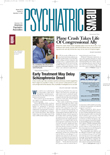Although the day will probably soon come when scientists find that a faulty gene, or lack of a gene, underlies a certain psychiatric disorder, that information alone won’t lead to successful therapy for it.
“We can’t just throw drugs at a gene,” said Joshua Gordon, M.D., Ph.D., a research fellow in psychiatry at Columbia University. So what has to be done? Find out how the quirky gene or missing gene causes the illness, then target drugs at the process, Gordon believes.
Gordon and his colleagues, in fact, are practicing that philosophy—at least in mice. They have conducted an experiment to find out how a gene missing in anxious mice actually triggers the rodents’ anxiety. Their results suggest that the missing gene does so by putting neurons in the hippocampal region of the brain into overdrive.
Gordon reported these results at the 14th Annual Scientific Symposium of the National Alliance for Research on Schizophrenia and Depression, held in New York City last month. NARSAD organized the symposium to showcase Gordon and some of its other young investigators who it believes are doing promising psychiatric research.
Mice have been bred to lack the gene that makes one of the various nerve receptors that receive messages from the neurotransmitter serotonin. Mice lacking the gene for serotonin-1A receptor appear to be more anxious than their littermates with the gene, and if they are given antianxiety medications, they seem to calm down. Thus, lack of the serotonin-1A gene and of the serotonin-1A receptor in turn appear to be responsible for excessive anxiety in these mice.
Gordon and his colleagues decided to conduct an experiment to see what happens to the brains of the mice lacking the serotonin-1A receptor gene when they are placed in an anxiety-inducing situation. In other words, they hoped to identify brain activity provoked by the missing gene that might explain the animals’ excessive anxiety.
First, they obtained mice lacking the serotonin-1A receptor gene, as well as some of the mice’s littermates that had the gene. They then operated on each of the mice to implant electrodes in the two hippocampi of its brain. The hippocampus was formerly thought to be involved only in learning and memory, but now it seems to be implicated in schizophrenia, bipolar disorder, depression, and anxiety as well. What’s more, the hippocampus is normally rich in serotonin-1A receptors. The scientists were also careful to implant the electrodes in such a way that they could record electrical signals from individual neurons in each mouse’s hippocampi.
After the mice had recovered from surgery, the researchers gave them the opportunity to explore an open maze. Mice generally prefer closed mazes to open ones, probably because they feel more secure in the former, and these mice were no exception. However, the mice lacking the serotonin-1A receptor gene were even more reluctant to go into the open maze than their littermates with the gene.
As the mice approached the open maze, electrical signals were recorded from neurons in their hippocampi. The hippocampal neurons of the mice without the gene gave off more electrical signals than did the hippocampal neurons of the mice with the gene, the researchers discovered.
Thus, a lack of the serotonin-1A gene may lead to excessive neuronal activity in the hippocampus during stressful situations, and the excessive neuronal activity in turn may switch on anxiety, Gordon and his colleagues concluded. If this conclusion is correct, Gordon explained at the symposium, hippocampal neurons might constitute good targets for new kinds of antianxiety drugs.
“This is state-of-the-art genetic work” combined with electrophysiology, said Frances Benes, M.D., Ph.D., a professor of psychiatry at Harvard University, at the symposium.
“This is a powerful experimental paradigm that Dr. Gordon has put together,” she commented, “. . .and it is a model for individuals who have had anxiety since the time they are born.”
The research was funded by a NARSAD Young Investigator Award, a National Institute of Mental Health Institutional Training Fellowship, and an APA-Wyeth Ayerst M.D./Ph.D. Fellowship. ▪

